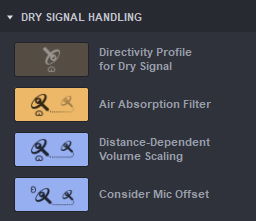After much more experiments I have discovered the following:
The volume scaling is CORRECT but only if you treat your instruments as "recorded WITHOUT spot microphones". In my opinion, the volume scaling has to be applied ONLY to the WET signal, not the dry. Because a spot microphone mixed in means you add volume to the mix. With the volume scaling enabled it would mean you only hear the main microphone. And this is something I never understood with MIR Pro. You always hear both signals with MIR Pro, i.e. the concept of main + spot. In a normal recording scenario you delay the spot microphone, but still has it's volume. With the volume scaling you move the spots further back and lose this volume, which is not right. Yes, the concept of MIR Pro is to have perfectly time-aligned spots, but the "real" spots are, as said, delayed and don't lose volume.
With the strings it's not a problem, because they are at the front, but with the other instruments I always switched between volume scaling on and off, only to understand that the volume scaling itself is the problem. ;)
I would like to hear what Dietz has to say about this. Would be nice to have a feature which disables the volume scaling on the spots (i.e. dry) signal. Of course, with VE Pro I can separate the dry and wet signal and compensate the volume, but it's tedious, because I don't exactly know the volume differences which are applied by the scaling. Or is there a rule of thumb (1m = XX db)?
